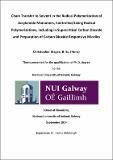| dc.contributor.advisor | Aldabbagh, Fawaz | |
| dc.contributor.author | Magee, Christopher | |
| dc.date.accessioned | 2015-01-08T17:41:33Z | |
| dc.date.issued | 2014-12-11 | |
| dc.identifier.uri | http://hdl.handle.net/10379/4808 | |
| dc.description.abstract | Chapter 1 provides a general introduction to radical polymerization, including chain transfer, and controlled/living radical polymerization. A review of the literature since 2009 on heterogeneous controlled/living radical polymerizations in supercritical carbon dioxide is provided.
Chapter 2 describes the work published in Polymer Chemistry 2014, 5, 2259-2265. Chain transfer to solvent in conventional radical polymerization of N-tert-butylacrylamide (TBAM) and N-(2-morpholin-4-ylethyl)acrylamide (MEA) in a range of alcohol solvents at 120 °C was investigated. Mayo analysis of polymerizations of TBAM in linear alcohols (C3-C9) resulted in an approximately linear increase in chain transfer to solvent constant (Ctr,S) with the number of methylene (CH2) units in the solvent. The solvents with the lowest chain transfer to solvent constant (Ctr,S) allowed the attainment of higher molecular weight (MWs) in both conventional and nitroxide-mediated radical polymerization (NMP) of TBAM. The first controlled/living polymerizations of MEA are detailed with chain transfer having a greater impact on maximum achievable MWs in NMP in comparison to TBAM.
Chapter 3 gives an account of work published in Polymer Chemistry 2014, 5, 5725-5733. The first alkoxyamine-initiated precipitation polymerization of styrene in supercritical carbon dioxide is provided. Reasonable controlled/living character using TIPNO-Alkoxyamine was possible in the absence of any excess free nitroxide. The analogous SG1-alkoxyamine gave inferior control under the same conditions. Nitroxide partitioning effects were investigated by comparing the relative performances of three novel fluorinated TIPNO based alkoxyamines. Despite increased steric bulk around the N-O bond, all polymerization using these three alkoxyamines proceeded at a similar rate and level of control to the TIPNO system in solution. These experiments were supported by PREDICI simulation of the partitioning effects of the styrene/TIPNO system in scCO2.
Chapter 4 describes the controlled/living reversible addition-fragmentation transfer (RAFT) polymerization of MEA. The morpholine moieties of the poly(MEA) were shown by 1H NMR spectroscopy to be reversibly protonated in aqueous solutions of CO2. Poly(MEA) was chain extended with N,N-dimethylacrylamide and styrene to yield amphiphilic triblock copolymer, which self-assembled in water to form uniform spherical micelles of 25 nm in diameter. Colloidal aggregation was reduced by addition of CO2 in water with micelles appearing larger and more irregular in size. | en_US |
| dc.rights | Attribution-NonCommercial-NoDerivs 3.0 Ireland | |
| dc.rights.uri | https://creativecommons.org/licenses/by-nc-nd/3.0/ie/ | |
| dc.subject | Polymer Chemistry | en_US |
| dc.subject | Radical Polymerization | en_US |
| dc.subject | Controlled/Living Radical Polymerization | en_US |
| dc.subject | Supercritical Carbon Dioxide | en_US |
| dc.subject | Chain Transfer | en_US |
| dc.subject | School of Chemistry | en_US |
| dc.title | Chain transfer to solvent in the radical polymerization of acrylamide monomers, controlled/living radical polymerizations, including in supercritical carbon dioxide and preparation of carbon dioxide responsive micelles | en_US |
| dc.type | Thesis | en_US |
| dc.contributor.funder | Irish Research Council | en_US |
| dc.description.embargo | 2018-12-04 | |
| dc.local.final | Yes | en_US |
| nui.item.downloads | 227 | |


